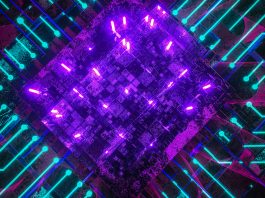A collaborative project between German researchers is delivering the necessary conditions for scalable diamond quantum microprocessors.
Researchers from the Fraunhofer Institute for Applied Solid State Physics IAF and the Institute of Quantum Optics at Ulm University, along with the start-up, Quantum Brilliance, are making advancements in economically viable and scalable quantum computing with diamond quantum microprocessors under development.
The German Federal Ministry of Education and Research (BMBF) is funding the collaboration with €15.6m via the ‘Enabling Start-up’ measure.
Quantum processing units
The joint project – named Deutsche Brilliance – intends to exploit the special material properties of diamond and produce novel technologies for developing and controlling diamond quantum microprocessors – quantum processing units, or QPUs – by 2025.
The aim of QPUs is to offer quantum advantages for functions like edge computing—a basic technological precondition for the intricate infrastructure of the Internet of Things (IoT), which can facilitate autonomous mobility and digitised industrial production.
Assessing diamond quantum microprocessors
One significant difficulty in the advancement of quantum computers is the technological realisation of quantum bits (qubits). Qubits can be developed through several methods; for example, they can be produced based on nuclear spins in solids. In this respect, a new approach is the utilisation of diamond as a host material.
Diamond-based quantum computers offer potential considerable benefits in regard to practical applications: they can be constructed and run more energy-efficiently, consistently and compactly than quantum processors based on superconducting qubits.
As well as this, it is not necessary to cool them to cryogenic temperatures or evacuate them in complex systems. In fact, diamond qubits function at room temperature and normal pressure ratios because of the exceedingly stable diamond crystal lattice.
Diamond qubits
Diamond qubits are generated through the quantum entanglement of quasi-free electrons in nitrogen-vacancy centres (“NV centres” ) of the diamond crystal lattice. Nevertheless, existing techniques for the fabrication of such NV centres do not permit an upscaling of diamond-based qubits to adequately large assemblies of multiple qubits in the form of arrays, which are required for quantum computing.
Currently, techniques that enable a defined placement of nitrogen atoms in the crystal lattice are scarce. This, however, is essential for the coupling of multiple NV centres to create larger arrays.
The manufacturing process
During its subproposal within the joint project, Fraunhofer IAF is establishing growth processes for diamond substrates of the maximum purity and quality. In partnership with Quantum Brilliance, it is also developing precision manufacturing methods for the construction of scalable arrays of diamond qubits. Researchers of Fraunhofer IAF hope to accomplish the required local accuracy in the placement of nitrogen atoms of less than one nanometre by employing scanning probe microscopy.
“This approach for the targeted placement of NV centres is so far unique and a crucial step towards scaling NV arrays for quantum computing applications,” explained Dr Ralf Ostendorf, project leader on the side of Fraunhofer IAF.
Due to this, the collaborative project will also add to the future growth of the technology with regard to upcoming research projects, on top of industrial applications in the fields of sensor technology, imaging or communication.
Parallel to the Fraunhofer IAF subproject, a team led by Professor Dr Fedor Jelezko at the Institute for Quantum Optics of Ulm University is working on defining scalable readout and control methods for diamond-based qubits, which will enable their precise operation.
Quantum Brilliance at the site of Fraunhofer IAF
Fraunhofer IAF and Quantum Brilliance are working closely within the framework of ‘DE-Brill’. In order to utilise the facility infrastructure at the Freiburg site and to guarantee short exchange cycles, Fraunhofer IAF has welcomed a team from Quantum Brilliance to exclusively use the institute’s own premises for this purpose.
The collaborative location permits the partners to respond rapidly to measurement and characterisation results, to directly enhance ongoing experimental processes and to preserve a continuous exchange of knowledge.









